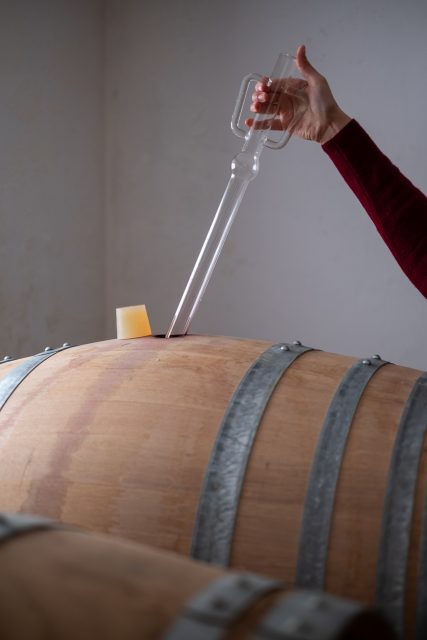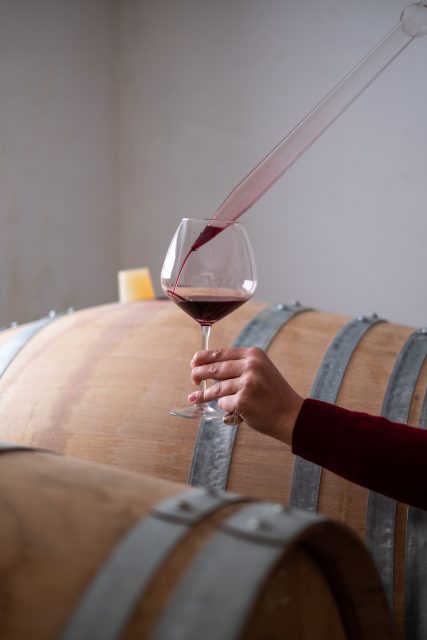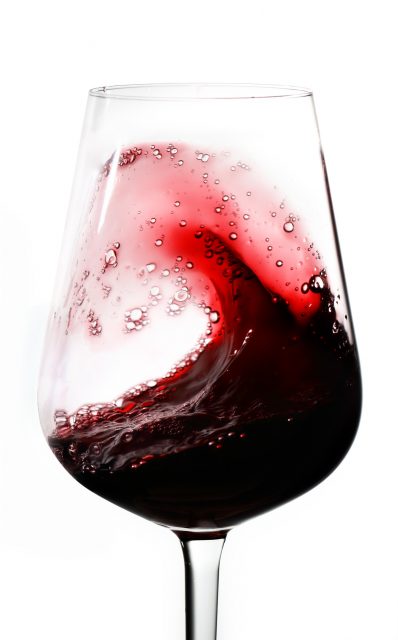This website uses cookies so that we can provide you with the best user experience possible. Cookie information is stored in your browser and performs functions such as recognising you when you return to our website and helping our team to understand which sections of the website you find most interesting and useful.
Bordeaux 2020 en primeur: The pitfalls of scoring from tasting samples
Our Bordeaux correspondent, Colin Hay, defends the use of itinerant en primeur tasting samples, with one or two caveats, arguing that the practice should now be normalised.

A year on and we are at it again. International critics, merchants, brokers, retailers and assorted other intermediaries in the near-global en primeur supply chain are engaged in a practice that was considered, this time last year, a one-off, a never-to-be-repeated exception, a necessary but unfortunate innovation fashioned in adversity.
In a sense, there is nothing surprising about that; for the exceptional conditions that justified the exception remain. That exception has yet to become the new normal. But for la place de Bordeaux and its global tentacles it is part of what passes for normality today.
The practice, of course, is the tasting of itinerant en primeur samples. So, one year on, what do we make of this practice and how does that help us think about the en primeur campaign that might well see its first releases within a fortnight? Could and should today’s exception become the new normal?
That we are all doing more or less exactly what we were doing this time last year is, of course, a consequence of the global public health crisis that forms, as it did then, the immediate backdrop to the en primeur campaign.
Its effect is to make international wine critics, almost all of whom have been unable to travel to Bordeaux, reliant on tasting samples sent or couriered to them by the chateaux themselves (or, increasingly, by agents and associations acting on their behalf).

This, of course, applies to me too. I am not exactly a neutral observer of this practice. Like other Bordeaux commentators and critics, I am reliant upon it – a participant observer, if you like.
But as a practice it raises a whole host of issues – some new, some not so new. And those issues need to be aired and, ideally, debated publicly. This short piece is as much an attempt to draw attention to these issues as it is a contribution to resolving them. That said, it does conclude with a series of proposals – some of them I imagine, quite controversial.
So what are the issues here? They are closely inter-related but, for me at least, they concern the quality, the variability and the distribution of samples. Together, they raise concerns about the reliability and the very role of critical appreciation and, potentially, the value of scores as guides to the purchase of wines in this vintage.
There is, of course nothing unusual about critics tasting samples. En primeur has always relied on the international wine trade and international critics descending on Bordeaux to taste more or less representative samples of unfinished wines drawn from the barriques (and now foudres and amphorae) of the leading properties.
In some cases, those samples are of the final assemblage (or blend); in many other cases what is presented to the itinerant critic is an ‘approximate’ final blend, produced solely for the en primeur tastings themselves; and in other cases the sample is more simply drawn from a barrel that happens to be tasting well on that particular day.
There have always been questions, concerns and suspicions about the representativeness of such samples. The more cynically minded have invariably drawn attention to the opportunity for mischief.
Might not chateaux benefit from presenting subtly different samples to different critics with known (or perceived) preferences for this or that – greater or lesser extraction, more or less tangible oak presence and so forth?
They have typically also suggested that the barriques from which the en primeur samples are chosen are likely to flatter somewhat the quality of the final wine. If barrel A simply tastes better, at this stage, than barrel B who could resist the temptation to draw the en primeur samples disproportionately from it?
Maybe. As it happens I am not especially cynical about the preparation of samples. Evidence of systematic abuse is very limited and invariably both anecdotal and historic, where it exists at all. That won’t convince the sceptic; and it is not really intended to do so. My point here is not about the ‘normal’ practice of tasting of en primeur samples (problematic, for some of these reasons, and many others) though it may well be.
My point is about the far from normal – and arguably less optimal still – tasting of itinerant samples that we are all now engaged in. Here, again, it is important to be crystal clear. I am not suggesting that there is a better way to conduct en primeur this year. Indeed, perhaps surprisingly, I will conclude by defending the value of itinerant tasting samples. I will even argue that they have an important role to play once the exception of Covid has passed.

What is immediately clear is that today’s circumstances do not permit normality. But what I am suggesting is that we need to be very clear about the sub-optimal character of the en primeur tasting that is now going on.
Above all, as critics and commentators, we need to take the responsibility for sharing our dilemma and our concerns with those for whom we write, who typically have no chance of tasting these wines before they decide whether or not to buy them.
An en primeur sample is a fragile thing. The clock starts ticking the moment the sample is drawn from the barrique. With every passing hour the sample degrades; though the rate of degradation varies greatly – depending on the wine itself, the specific barrique from which it is drawn, the preparation of the sample, the size of the vessel in which the sample is conveyed, the enclosure used to seal the sample and, above all, the conditions in which the sample is stored, the distance it has travelled, and the time it has spent in transit before it is tasted.
A week is a very long time in the life and demise of an en primeur barrel sample. And herein lies the first problem.
At the time of writing this I have tasted around 300 itinerant 2020 en primeur samples. The vast majority of these were sent directly to me at home in Paris by the chateaux themselves or by their consultant oenologists or other agents acting on their behalf.
Others I have tasted at professional group tastings (like the UGCB tasting), again in Paris, and just a handful of others I have tasted in private tastings with the wine-maker also in Paris. Samples sent directly to me from Bordeaux typically arrive within 48 hours and, if they have come directly from the chateau, they are very rarely more than 72 hours old when I receive them.
That, it turns out, is good. Samples that have been delayed in transit and that have arrived, say, 4-5 days after they were drawn from their barrique have, in almost all cases, suffered for that. Indeed, in each such case I have sought a new and fresher sample; and every single time without exception, that has turned out to be better.
Samples, however, sent by intermediaries, whilst they take no longer to arrive, were invariably prepared two (and sometimes three or even four) days before they were sent – and that starts to become a problem.
Worst still, most of the samples at professional group tastings in my experience are at least 5 days old when they arrive at their destination. That, for me, is a problem and I have tried not to rely on tastings of that kind without at least attempting to re-taste the wine a second or third time from a directly conveyed sample or from the property itself. That final option is, of course, is easier for me, based as I am in Paris.
In short, an impressive proportion of barrel samples, conveyed either by intermediaries or for group tastings, arrive – even in Paris – almost a week after they were drawn. Some of them are fine; but crucially, others are not. It hardly needs to be said, but the situation is unlikely to be better if the destination is further afield – London, Hong Kong or New York.

That brings me to a second point – arguably the crux of the matter for this vintage. The question is simply put: how do samples deteriorate? The answer is very clear, to me at least, on the basis of having explored the question directly over the last 3-4 weeks with the samples I have received.
Samples that remain unopened and tightly sealed deteriorate, at least in this vintage, quite rapidly (and certainly after 3-4 days) in the following ways: (i) they lose aromatic definition and precision and become more dull and more homogeneous on the nose; (ii) crucially, they lose brightness on the attack, delineation (layering), precision and definition in the mid-palate and lift on the finish; (iii) their tannins lose grip and focus and become more evenly distributed over the palate such that the structural detail of the wine becomes blurred; and (iv) any fine-grained pixilation and any translucence and/or clarity in the mid-palate is lost or diluted.
It might also be added that samples, on opening, typically blossom over a (variable) period of around 2 hours before starting to deteriorate in at least some of the above ways.
The more I reflect on the above list, the more it troubles me; and it troubles me greatly. Why? Because each and every one of the items that it contains is the difference, in this vintage above all, between a wine, for me at least, being judged a success and a wine being judged a failure.
This is a vintage that is quite heterogeneous in quality and in which the very best wines are characterised by aromatic precision, lift, brightness, freshness, mid-palate delineation and definition, layering, pixilation, clarity and a wonderfully luminous quality.
The implications of this are perhaps already evident, but I will return to them at the end. In practice, I now typically reject around 5-10 per cent of the samples I receive/taste as damaged in some way (however minor) in transit or just by having been out of the barrel for too long.
But, in the end, it is simply not possible to know definitively and absolutely if it is the sample or the wine that is at fault – especially if the fault is that it lacks freshness, definition, precision, lift and/or delineation. And those are precisely the characteristics of the best wines of this vintage!
I think that those who read and follow the critical appreciation of this vintage deserve to know that. They need to hear something from us, as critics and commentators, about how we share that uncertainty and the associated risk – with them as consumers and, indeed, with the chateaux who generously provide us with the samples we taste. For it is they, in the end, who bear the lion’s share of the risk.
But what exactly is that risk? Put most simply it is that we taste and evaluate the quality of the sample as much as the quality of the wine itself.
What are the implications of this? I think they are three-fold: Critics and commentators (above all those who nail their colours to the mast by offering scores and ratings based on the tasting of itinerant samples) need to be clear (and, I would argue, clearer) about how they taste and, above all, how they draw critical inferences from what they taste.
We need to be clear that there is a strict hierarchy of sample types and modes of tasting en primeur. Best of all is to taste from the property directly. But it is extraordinarily time-consuming if it is to be done properly and most critics, in my experience, lack the time or patience to taste properly – though there are notable exceptions (and they are well known in Bordeaux).
The next best, perhaps surprisingly, is to taste at home from a fresh sample supplied directly by the property itself (and, ideally, not by an intermediary), taking the time to appreciate its opening and evolution from the moment the cork is pulled. All other modes of tasting and types of sample are distinctly sub-optimal.
Ironically perhaps, given where we started, for international critics at least there is no substitute to tasting itinerant en primeur The practice should, in my view, now become part of the new normal. I am not proposing that the sending of samples to critics replace face-to-face tasting in the properties themselves; I continue to see that as crucial and as the gold standard.
But I do think it now has a massive role to play in augmenting and supplementing visits to the properties themselves. It is also massively preferable to relying on professional group tastings, even those conducted in and around Bordeaux. For it gives to the critic the opportunity (and the time) to draw more carefully the tricky inferences about quality that their evaluations rely upon than they can in a face-to-face tasting experience at the property.
These conclusions may well be provocative. They are rather different from those I drew a year ago and they have been forged through the experience of relying on samples kindly couriered to me by the chateaux.
Necessity, as they say, is the mother of invention. It turns out that the invention of the itinerant tasting sample was perhaps not such a bad intervention after all.
Colin Hay is The Drinks Business’ Bordeaux Correspondent. He is also Professor of Political Science at Sciences Po in Paris where he works on the political economy of la place de Bordeaux and wine markets more generally. His Bordeaux 2020 coverage will continue with an overview of the vintage and then a series of appellation-by-appellation profiles with full tasting notes.

